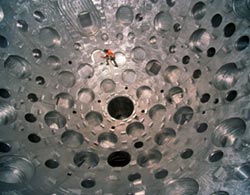Ever since 1960, when physicists Charles Townes and Arthur L. Schawlow of Bell Labs received the first patent for "Light Amplification by Stimulated Emission of Radiation," Lawrence Livermore National Laboratory (LLNL) has been engaged in the study and use of lasers. And for much of that time, Livermore has been home to the world's largest lasers.

THEN: Inside the Nova laser chamber. Nova, which operated at Livermore from the mid-1980s through the 1990s, produced 30 kilojoules of energy and 25 terawatts of power, making it the world's most powerful laser at the time.
Even though the lasers of the 60s were minuscule by today's standards, LLNL started evaluating the construction of high-power lasers and laser-driven implosion schemes. The most noteworthy system in those years was named Long Path, LLNL's first neodymium-doped glass disk and multi-pass laser (neodymium is a bright, silvery rare-earth metal used as the active lasing element).

NOW: Inside the 118,000-kilogram target chamber of the National Ignition Facility.
Completed in 2009, NIF is designed to generate 1.8 megajoules and 500 terawatts of ultraviolet laser energy, making Livermore once again home to the world's most powerful laser facility.Beginning in 1972, Livermore scientists designed, built and operated a series of increasingly energetic and powerful solid-state systems. It all started with the "4 pi" system and continued with Janus, Cyclops, the two-beam Argus, the 20-beam Shiva, the two beams of Novette, the 10-beam Nova, Petawatt and Beamlet (see "Empowering Light: Historic Accomplishments in Laser Research," Science & Technology Review, September 2002).
And now, the National Ignition Facility continues that tradition. Since the last of its 192 beams were installed in 2009, NIF offers unique capabilities, including the most energy of any laser facility in the world.With its ability to provide a variety of laser pulse shapes and lengths, including the proposed ultrashort, petawatt (1015 watt) pulses, NIF also will offer more power than any other laser facility. NIF will be about 20 times more powerful than the Nova laser and will deliver about 60 times more energy. When Nova operated with ultraviolet light, it produced 30 kilojoules of energy and 25 terawatts of power. In contrast, the 192-beam NIF will generate 1.8 megajoules and 500 terawatts of ultraviolet laser energy.
LLNL technology has supplied the seed for other large glass laser efforts in the United States, including the Omega laser at the University of Rochester in New York and the Z-Beamlet laser now at Sandia National Laboratory in Albuquerque, NM. Lasers in Japan, France, the United Kingdom, Germany and other countries around the world also use LLNL-developed technology.
Source









0 comments:
Post a Comment
Thank you very much for your opinion